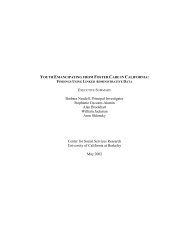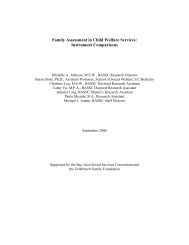Developing a Self-Assessment Toolfor Culturally - Office of Minority ...
Developing a Self-Assessment Toolfor Culturally - Office of Minority ...
Developing a Self-Assessment Toolfor Culturally - Office of Minority ...
You also want an ePaper? Increase the reach of your titles
YUMPU automatically turns print PDFs into web optimized ePapers that Google loves.
While many LPHAs currently provide CLAS to their clients in some form, studiesindicate that CLAS are delivered in ad hoc fashion, vary significantly in their quantity andquality (Association <strong>of</strong> State and Territorial Health Officials ASTHO 1992; Mertz andFinocchio 1999), and reflect differing views <strong>of</strong> what constitutes “culturally andlinguistically appropriate health care services” (U.S. Conference <strong>of</strong> Local Health <strong>Office</strong>rs1993). Studies have shown that racial and ethnic minorities and persons with limitedEnglish pr<strong>of</strong>iciency (LEP) many times do not receive adequate services, and have to relyon family members, friends, or strangers who are not trained in the use <strong>of</strong> medicalterminology to guide them through a medical encounter (Milne 2000; National Association<strong>of</strong> County and City Health Officials NACCHO 1992). This is important because it isreported that 25 to 50 percent <strong>of</strong> words and phrases are incorrectly relayed in ad hocinterpretations, which significantly impacts the effectiveness and quality <strong>of</strong> health careservices (Interpreter Standards Advisory Committee 1998). Therefore, it was the project’sgoal to aid LPHAs by operationally defining CLAS in a systematic manner and provide anappropriate tool to help them collect important information about the extent <strong>of</strong> their CLASprovision.The remainder <strong>of</strong> this chapter presents current research that identifies evidence <strong>of</strong>persistent health disparities for racial and ethnic minorities, describes the important rolethat LPHAs play within the U.S. public health system, and describes the background underwhich the project was conceived. Chapter 2 presents the project’s methodology, whichincludes a review <strong>of</strong> the literature and relevant tools (that guided the revisions to theinstruments); the conceptual framework adopted from the CLAS in MCOs study; and theprocess employed to develop and revise the self-assessment tool. Chapter 3 reviews theresulting instruments which comprise the self-assessment tool, as well as recommendationson how to effectively use the tool.1.1 EVIDENCE OF PERSISTENT DISPARITIES IN HEALTH STATUS ANDHEALTH CARE QUALITYDespite steady improvements in the overall health <strong>of</strong> the nation, studies conducted inthe last decade confirm that racial and ethnic minorities continue to experience many healthdisparities (DHHS 1991; HRSA 2000). For instance, between 1997 and 1999, the infantmortality rate was highest for infants <strong>of</strong> non-Hispanic African American mothers (Pastor etal. 2002), and the infant mortality rate for African Americans was more than twice that <strong>of</strong>whites (Cohen and Goode 1999). Moreover, in 1999, age-adjusted death rates for theAfrican American population exceeded those for the white population by 38 percent forstroke, 28 percent for heart disease, 27 percent for cancer, and more than 700 percent forHIV disease (Pastor et al. 2002).In addition, rates for all types <strong>of</strong> cancer are higher for African Americans than forwhites (DHHS 1991), and although African American and white women are screened forCOSMOS Corporation, December 2003 1-2
















